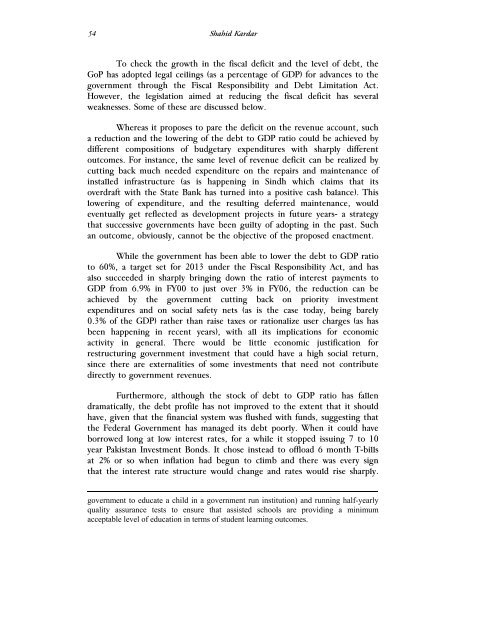Special Edition-07.pdf - Lahore School of Economics
Special Edition-07.pdf - Lahore School of Economics
Special Edition-07.pdf - Lahore School of Economics
You also want an ePaper? Increase the reach of your titles
YUMPU automatically turns print PDFs into web optimized ePapers that Google loves.
54<br />
Shahid Kardar<br />
To check the growth in the fiscal deficit and the level <strong>of</strong> debt, the<br />
GoP has adopted legal ceilings (as a percentage <strong>of</strong> GDP) for advances to the<br />
government through the Fiscal Responsibility and Debt Limitation Act.<br />
However, the legislation aimed at reducing the fiscal deficit has several<br />
weaknesses. Some <strong>of</strong> these are discussed below.<br />
Whereas it proposes to pare the deficit on the revenue account, such<br />
a reduction and the lowering <strong>of</strong> the debt to GDP ratio could be achieved by<br />
different compositions <strong>of</strong> budgetary expenditures with sharply different<br />
outcomes. For instance, the same level <strong>of</strong> revenue deficit can be realized by<br />
cutting back much needed expenditure on the repairs and maintenance <strong>of</strong><br />
installed infrastructure (as is happening in Sindh which claims that its<br />
overdraft with the State Bank has turned into a positive cash balance). This<br />
lowering <strong>of</strong> expenditure, and the resulting deferred maintenance, would<br />
eventually get reflected as development projects in future years- a strategy<br />
that successive governments have been guilty <strong>of</strong> adopting in the past. Such<br />
an outcome, obviously, cannot be the objective <strong>of</strong> the proposed enactment.<br />
While the government has been able to lower the debt to GDP ratio<br />
to 60%, a target set for 2013 under the Fiscal Responsibility Act, and has<br />
also succeeded in sharply bringing down the ratio <strong>of</strong> interest payments to<br />
GDP from 6.9% in FY00 to just over 3% in FY06, the reduction can be<br />
achieved by the government cutting back on priority investment<br />
expenditures and on social safety nets (as is the case today, being barely<br />
0.3% <strong>of</strong> the GDP) rather than raise taxes or rationalize user charges (as has<br />
been happening in recent years), with all its implications for economic<br />
activity in general. There would be little economic justification for<br />
restructuring government investment that could have a high social return,<br />
since there are externalities <strong>of</strong> some investments that need not contribute<br />
directly to government revenues.<br />
Furthermore, although the stock <strong>of</strong> debt to GDP ratio has fallen<br />
dramatically, the debt pr<strong>of</strong>ile has not improved to the extent that it should<br />
have, given that the financial system was flushed with funds, suggesting that<br />
the Federal Government has managed its debt poorly. When it could have<br />
borrowed long at low interest rates, for a while it stopped issuing 7 to 10<br />
year Pakistan Investment Bonds. It chose instead to <strong>of</strong>fload 6 month T-bills<br />
at 2% or so when inflation had begun to climb and there was every sign<br />
that the interest rate structure would change and rates would rise sharply.<br />
government to educate a child in a government run institution) and running half-yearly<br />
quality assurance tests to ensure that assisted schools are providing a minimum<br />
acceptable level <strong>of</strong> education in terms <strong>of</strong> student learning outcomes.

















